2021年
2022年シーズンの内容については
こちらを参照ください。
現在のF1のタイヤはワンメイクと定められており、2021年シーズンのF1のタイヤは2020年シーズンに続いてイタリアの『ピレリ』が供給しています。

現在のF1タイヤのコンパウンドは晴れ用の『ドライタイヤ』が5種類、雨用の『レインタイヤ』が2種類が設定されています。
各レースごとに5種類のドライタイヤの中から3種類が選択され、コンパウンドの硬い順に『ハード』、『ミディアム』、『ソフト』と呼ばれます。この3種類のドライタイヤと2種類のレインタイヤが各レースで使用されます。
これらのタイヤを外見で識別できるようにタイヤのサイドウォールにペイントが施されます。
ドライタイヤ (5種類)
F1では2019年シーズンからピレリが供給するドライタイヤのコンパウンドが5種類となりました。
この5種類のコンパウンドは硬い順から、『C1、C2、C3、C4、C5』と呼びます。
ピレリはF1が開催サーキットの路面や気温などの特性を考慮し、この5種類の中から3種類のコンパウンドを事前に選択し各レースに投入します。
各レースに投入される3種類のタイヤはコンパウンドが硬い順に『ハードタイヤ』、『ミディアムタイヤ』、『ソフトタイヤ』と呼びます。
ドライタイヤのサイドウォールは以下に示す色にペイントが施され、どのコンパウンドのタイヤが装着されているのか外見で識別できるようになっています。
ハード タイヤ
(ホワイト)
ミディアム タイヤ
(イエロー)
ソフト タイヤ
(レッド)
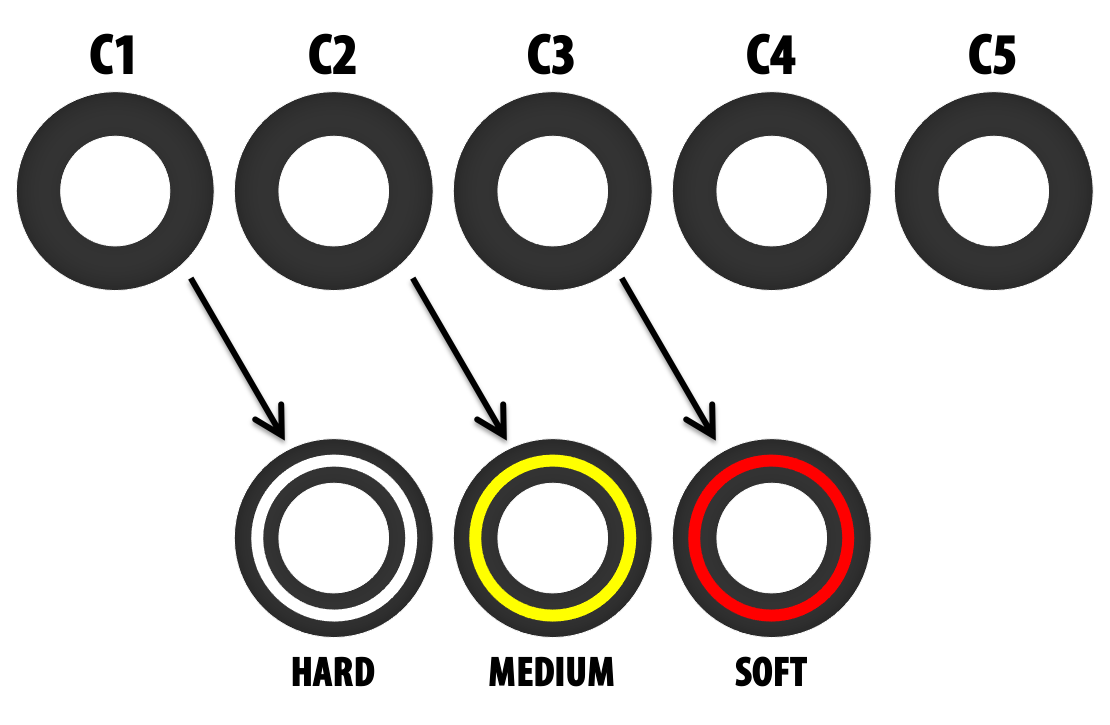
一般的にタイヤは、柔らかいコンパウンドはグリップ力が高く、耐久性が低い特性を持っています。また、硬いコンパウンドはグリップ力が低く、耐久性が高い特性を持っています。
ただし、サーキット毎に異なる路面の状況や路面温度などとコンパウンドの相性があるため、常に柔らかいコンパウンドの方が速く走ることができるとは限りません。
各レースでどのコンパウンドが投入されるのかは、FIAとピレリによって事前に選択されます。
どのようなコンパウンドが選択されるのかについては、遅くともヨーロッパで開催されるレースにおいては9週間前、ヨーロッパ外で開催されるレースにおいては15週間前に発表されます。
2021年 コンパウンドの仕様変更
ピレリは2019年と2020年シーズンは同じタイヤコンパウンドを供給してきましたが、2021年シーズンは耐久性を高めた新しいコンパウンドのタイヤに変更されます。
空力性能の進化により、2020年シーズンよりもダウンフォースレベルが向上すると考えられているためです。
2021年 各グランプリ供給タイヤ
| グランプリ | C1 | C2 | C3 | C4 | C5 |
| 第1戦 バーレーンGP | ● | ● | ● | ||
| 第2戦 エミリア・ロマーニャGP | ● | ● | ● | ||
| 第3戦 ポルトガルGP | ● | ● | ● | ||
| 第4戦 スペインGP | ● | ● | ● | ||
| 第5戦 モナコGP | ● | ● | ● | ||
| 第6戦 アゼルバイジャンGP | ● | ● | ● | ||
| 第7戦 フランスGP | ● | ● | ● | ||
| 第8戦 シュタイアーマルクGP | ● | ● | ● | ||
| 第9戦 オーストリアGP | ● | ● | ● | ||
| 第10戦 イギリスGP | ● | ● | ● | ||
| 第11戦 ハンガリーGP | ● | ● | ● | ||
| 第12戦 ベルギーGP | ● | ● | ● | ||
| 第13戦 オランダGP | ● | ● | ● | ||
| 第14戦 イタリアGP | ● | ● | ● | ||
| 第15戦 ロシアGP | ● | ● | ● | ||
| 第16戦 トルコGP | ● | ● | ● | ||
| 第17戦 アメリカGP | ● | ● | ● | ||
| 第18戦 メキシコGP | ● | ● | ● | ||
| 第19戦 サンパウロGP | ● | ● | ● | ||
| 第20戦 カタール | ● | ● | ● | ||
| 第21戦 サウジアラビアGP | ● | ● | ● | ||
| 第22戦 アブダビGP | ● | ● | ● |
Tyres, glorious tyres 😍@pirellisport nominate the compounds for all 23 races in 2021#F1 https://t.co/ak9RMwJ6uB
— Formula 1 (@F1) February 19, 2021
| グランプリ | C1 | C2 | C3 | C4 | C5 |
| 第1戦 オーストリアGP | ● | ● | ● | ||
| 第2戦 オーストリアGP | ● | ● | ● | ||
| 第3戦 ハンガリーGP | ● | ● | ● | ||
| 第4戦 イギリスGP | ● | ● | ● | ||
| 第5戦 イギリスGP | ● | ● | ● | ||
| 第6戦 スペインGP | ● | ● | ● | ||
| 第7戦 ベルギーGP | ● | ● | ● | ||
| 第8戦 イタリアGP | ● | ● | ● | ||
| 第9戦 トスカーナGP | ● | ● | ● | ||
| 第10戦 ロシアGP | ● | ● | ● | ||
| 第11戦 アイフェルGP | ● | ● | ● | ||
| 第12戦 ポルトガルGP | ● | ● | ● | ||
| 第13戦 エミリアロマーニャGP | ● | ● | ● | ||
| 第14戦 トルコGP | ● | ● | ● | ||
| 第15戦 バーレーンGP | ● | ● | ● | ||
| 第16戦 サクヒールGP | ● | ● | ● | ||
| 第17戦 アブダビGP | ● | ● | ● |
レインタイヤ (2種類)
F1では雨で濡れた路面を走行するためのレインタイヤは『インターミディエイトタイヤ』と『ウェットタイヤ』の2種類が設定されています。
インターミディエイト タイヤ
(グリーン)
浅溝のインターミディエイトタイヤは、小雨の時の路面や雨があがり路面が乾いてきたような場合に使われます。
ウェット タイヤ
(ブルー)
深溝のウェットタイヤは水はけ性能が高く、雨天時のタイヤとして使われます。しかし、強い雨が降っている場合はウェットタイヤでも安定した走行は困難です。

各グランプリで供給されるタイヤセット数
F1では各グランプリにおいてドライバー毎に供給されるタイヤのセット数はドライタイヤが13セット、レインタイヤが4セットと決められています。
ドライタイヤ 13セット
2021年シーズンのF1では、供給される13セットのドライタイヤのコンパウンドの内訳はハードタイヤか2セット、ミディアムタイヤが3セット、ソフトタイヤがか8セットと定められています。
このうち、ハードタイヤとミディアムタイヤの各1セットずつは決勝以外で使用することができません。ソフトタイヤのうち、1セットは公式予選Q3専用のタイヤとなります。
ハード タイヤ
2セット
ミディアム タイヤ
3セット
ソフト タイヤ
8セット
2019年シーズン以前では、供給される13セットのドライタイヤのうち、10セットのコンパウンドの内訳をドライバーごとに任意に選択できるレギュレーションとなっていました。
2020年シーズンでは、新型コロナウイルスの感染拡大の影響を受け、短期間で多くのレースを開催することになったため、ドライバーごとにタイヤコンパウンドを自由に選択することができなくなりました。ハードタイヤが2セット、ミディアムタイヤが3セット、ソフトタイヤが8セットの合計13セットが供給されました。
2021年シーズンは2020年シーズンのレギュレーションを踏襲した内容になります。
レインタイヤ 4セット
レインタイヤは浅溝のインターミディエイトタイヤと深溝のウェットタイヤの2種類が設定されており、それぞれ2セットずつ供給されます。
インターミディエイト タイヤ
2セット
ウェット タイヤ
2セット
ドライタイヤの使用義務・タイヤの返却
ドライタイヤにはタイヤの使用義務と返却のルールがあります。
ハード、ミディアム、ソフトの3種類のコンパウンドのうち、各1セットずつ(合計3セット)には使用義務があります。
ソフトタイヤは公式予選Q3で使用することができ、Q3終了後は返却しなければなりません。
ハードタイヤとミディアムタイヤのどちらか1セットは決勝で必ず使用しなければなりません。
公式予選でQ3に進出したドライバーはQ2でベストタイムを記録したタイヤで決勝をスタートしなければなりません。
公式予選でQ3に進出できなかったドライバーは公式予選Q3用として供給されるソフトタイヤを決勝で使用することができます。
残り10セットのドライタイヤについては、以下のタイミングでタイヤを返却しなければなりません。
FP1開始40分後に1セットを返却
FP1終了から2時間以内に1セットを返却
FP2終了から2時間以内に2セットを返却
FP3終了から2時間以内に2セットを返却
レインタイヤの使用義務・タイヤの返却
フリー走行ではレースコントロールからウェット宣言が行われた場合に限り、雨用のインターミディエイトタイヤとウェットタイヤを使用することができます。
インターミディエイトタイヤの追加供給
金曜日に行われるフリー走行1回目とフリー走行2回目のどちらかでウェット宣言が行われた場合、インターミディエイトタイヤが追加で1セット供給されます。
また、フリー走行1回目とフリー走行2回目でウェット宣言が行われていないものの、土曜日に行われるフリー走行3回目でウェット宣言が行われる可能性が高い場合もインターミディエイトタイヤが追加で1セット供給されます。
ただし、追加で供給されたインターミディエイトタイヤは公式予選が開始するまでに返却しなければなりません。
ウェットタイヤの使用義務
大雨の影響により、レースがセーフティカー先導でスタートする場合、すべての車両はウェットタイヤを装着してスタートしなければなりません。
また、セーフティカーが解除となるまでは、ウェットタイヤ以外のタイヤに交換することが禁止されています。
レース中のタイヤ交換義務
F1ではレース中に1回以上のタイヤ交換を行うことが義務付けられています。また、レース中に2種類以上のコンパウンドのタイヤを使用しなければなりません。
また、決勝用として供給されたハードタイヤもしくはミディアムタイヤのうち、どちらかのタイヤを使用する必要があります。
早見表
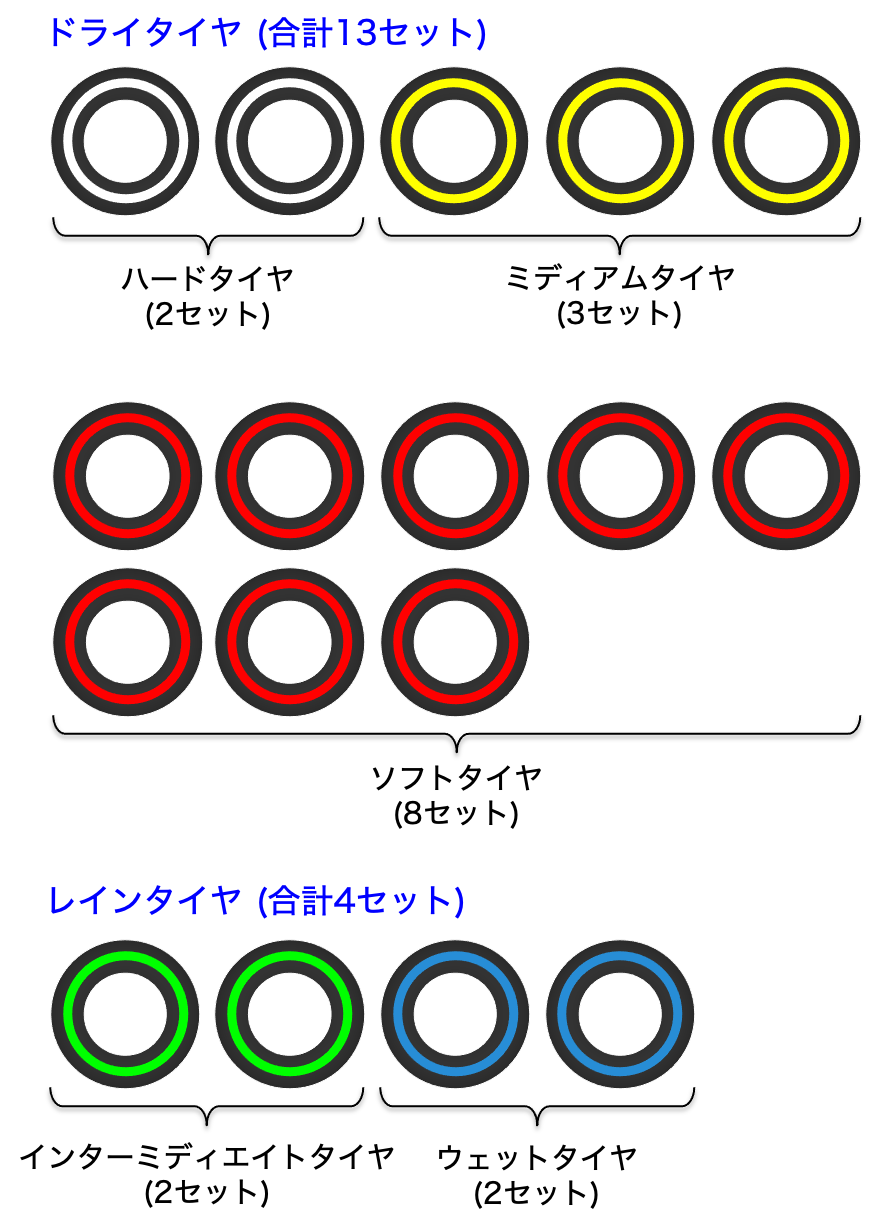
使用義務
- ソフトタイヤの1セットは公式予選Q3で使用することができ、Q3終了後は返却しなければならない。
- ハードタイヤとミディアムタイヤのどちらか1セットは決勝で使用しなければならない。
返却義務
- FP1開始40分後に1セットを返却
- FP1終了から2時間以内に1セットを返却
- FP2終了から2時間以内に2セットを返却
- FP3終了から2時間以内に2セットを返却
アーカイブ


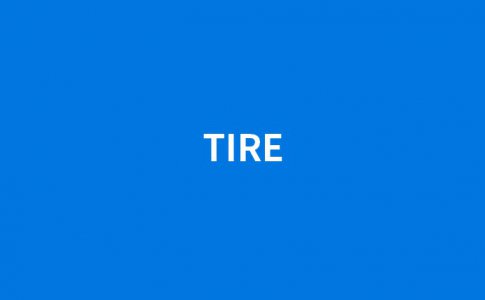


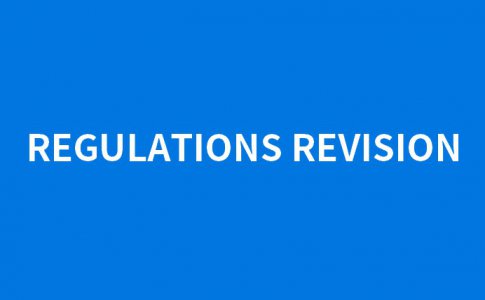




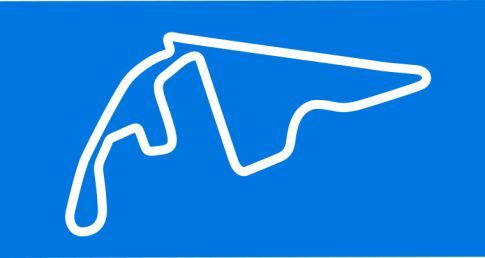

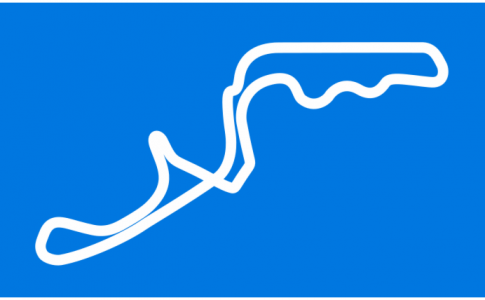

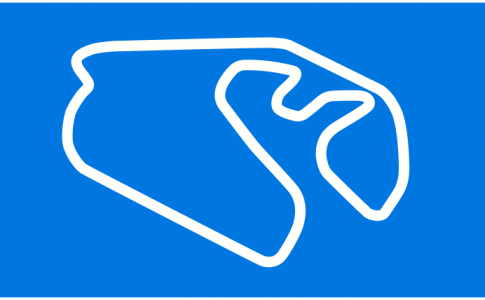
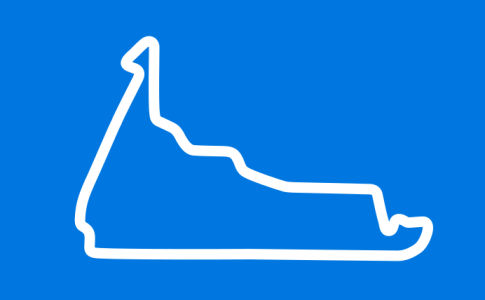



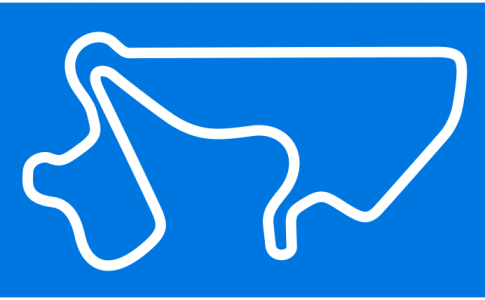

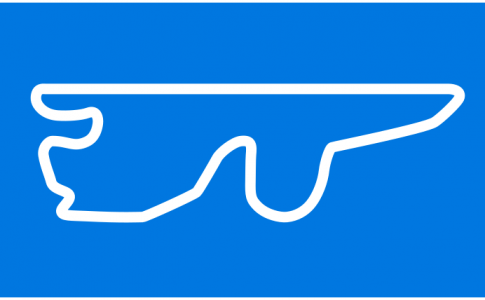
24) SUPPLY OF TYRES IN THE CHAMPIONSHIP AND TYRE LIMITATION DURING THE EVENT
24.1 Supply of tyres:
The single tyre manufacturer (the Supplier) appointed by the FIA must undertake to provide:
a) Three specifications of dry-weather tyre at each Event, each of which must be visibly distinguishable from one another when a car is on the track.
b) At certain Events one additional specification of dry-weather tyre may be made available to all Competitors for evaluation purposes following a recommendation to the FIA from the Supplier. Competitors will be informed about such an additional specification at least one week before the start of the relevant Event.
c) One specification of intermediate tyre at each Event.
d) One specification of wet-weather tyre at each Event.
24.2 Quantity, selection and specification of tyres during an Event:
a) Except under Articles 24.1(b), 24.4(e) and 24.4(f), no driver may use more than thirteen sets of dry-weather tyres, four sets of intermediate tyres and three sets of wet-weather tyres during an Event. A complete set of tyres will be deemed to comprise two front and two rear tyres all of which must be of the same specification and as allocated by the FIA, however, sets of the same specification may be mixed following the qualifying practice session.
b) Unless otherwise determined by the FIA and with the agreement of the Supplier, no less than two weeks prior to each Event, the FIA will provide all Competitors with the following information relevant to the Event in question:
i) Which tyre specifications will be made available by the Supplier.
ii) The mandatory dry-weather race tyre specification(s) (up to two).
iii) The mandatory dry-weather Q3 tyre specification (which will always be the softest of the three specifications).
Unless otherwise determined by the FIA and with the agreement of the Supplier, each Driver will be allocated the following specification of dry-weather tyres at each Event:
a) Two sets of the hard specification of tyres.
b) Three sets of the medium specification of tyres.
c) Eight sets of the soft specification of tyres.
c) Once the above selections have been made the Technical Delegate will allocate sets of tyres to each driver from among the stock of tyres the Supplier makes available for the Event.
24.3 Control of tyres:
a) The outer sidewall of all tyres which are to be used at an Event must be marked with a unique identification.
b) Other than in cases of force majeure (accepted as such by the stewards), all tyres intended for use at an Event must be presented to the Technical Delegate for allocation prior to the start of the Event.
c) At any time during an Event, and at his absolute discretion, the FIA Technical Delegate may select alternative dry-weather tyres to be used by any Competitor or driver from among the stock of tyres the Supplier has present at the Event.
d) A Competitor wishing to replace one unused tyre by another identical unused one must present both tyres to the Technical Delegate.
e) The use of tyres without appropriate identification may result in a grid position penalty or disqualification from the race.
24.4 Use of tyres:
The official return of tyres will be made electronically in accordance with the procedure described within the Appendix to these Sporting Regulations. Any set of electronically returned tyres must also be physically returned to the Supplier before the start of the following session.
a) All tyres must be operated in accordance with the prescriptions issued prior to each Event by the FIA and the procedures set out in the Appendix to these Sporting Regulations.
b) The only sets of tyres which may be used during an Event are those which are defined in Article 24.2(a).
Any driver who uses a set of tyres of differing specifications or tyres not allocated to him during the race may not cross the Line on the track more than twice before returning to the pits and changing them for a set of tyres of the same specification. A penalty under Article 38.3(d) will be imposed on any driver who does not change tyres as specified above. For the avoidance of doubt, a set of tyres of differing specifications will not be considered when assessing the number of specifications used during the race.
c) Tyres will only be deemed to have been used once the car’s timing transponder has shown that it has left the pit lane.
d) If an additional driver is used (see Article 26.1(b)) he must use the tyres allocated to the nominated driver he replaced.
e) If an additional specification of dry-weather tyre is made available in accordance with Article 24.1(b) two sets of these tyres will be allocated to each driver for use during P1 and P2. Any such tyres must be electronically returned no later than two hours after the end of P2.
f) If either P1 or P2 are declared wet one additional set of intermediate tyres will be made available to any driver who used a set of intermediate tyres during either session. Under such circumstances, one used set of intermediate tyres must be electronically returned before the start of the qualifying practice session.
If neither P1 nor P2 are declared wet, but the likelihood of P3 being declared wet is deemed by the FIA to be high, one additional set of intermediate tyres will be made available to all drivers. Under such circumstances, one set of intermediate tyres must be electronically returned before the start of the qualifying practice session.
g) From the thirteen (13) sets of dry-weather tyres allocated to each driver under Article 24.2(c):
i) One (1) set of the mandatory Q3 tyre specification may not be used nor returned before Q3 and, for the cars that qualified for Q3, one set of the same specification must be electronically returned no later than three and a half hours after the end of Q3.
ii) Two (2) sets of the mandatory race specification(s) may not be returned before the race. For the avoidance of doubt, if there are two mandatory race tyre specifications, one set of each specification may not be returned before the race.
From the ten remaining sets:
iii) One (1) set, which each Competitor must nominate prior to the start of P1 (or may re-nominate with the consent of the Technical Delegate), may only be used during the first 40 minutes of the session. If the session is stopped during the first 40 minutes the length of the stoppage will be added to the 40 minute limit. If P1 is declared wet before the start of the session or during the first 40- minutes, use will be extended for the remainder of the session. The extended use for this set of tyres will only be available to drivers who have either exited the pit lane more than once and/or crossed the Line on the track on either intermediate or wet-weather tyres.
iv) One (1) further set must be electronically returned no later than two hours after the end of P1.
v) Two (2) further sets must be electronically returned no later than two hours after the end of P2 unless both P1 and P2 are either declared wet or cancelled, in which case one of these sets may be retained by each driver but must be electronically returned no later than two hours after the end of P3.
vi) Two (2) further sets must be electronically returned no later than two hours after the end of P3.
h) Once all tyres have been returned electronically after P2 and the qualifying practice session the Supplier will publish a list of the tyres which each driver has available to him for the remainder of the Event.
i) Prior to the start of the qualifying practice session intermediate and wet-weather tyres may only be used after the track has been declared wet by the Race Director, following which intermediate, wet or dry-weather tyres may be used for the remainder of the session.
j) With the exception of any cars that are required to start the race from the pitlane, at the start of the race each car which qualified for Q3 must be fitted with the tyres with which the driver set his fastest time during Q2. This will only be necessary for these cars if dry-weather tyres were used to set the fastest time in Q2 and if dry-weather tyres are used at the start of the race.
Any such tyres damaged during Q2 will be inspected by the Technical Delegate who will decide, at his absolute discretion, whether any may be replaced and, if so, which tyres they should be replaced with.
A penalty under Article 38.3(d) will be imposed on any driver whose car is not fitted with the tyres with which he set his fastest time in Q2 (except if damaged tyres have been replaced with the approval of the Technical Delegate).
k) Unless he has used intermediate or wet-weather tyres during the race, each driver must use at least two different specifications of dry-weather tyres during the race, at least one of which must be a mandatory dry-weather race tyre specification as defined in Article 24.2(b). Unless a race is suspended and cannot be re-started, failure to comply with this requirement will result in the disqualification of the relevant driver from the race results.
If the race is suspended and cannot be re-started, thirty seconds will be added to the elapsed time of any driver who was unable to use at least two specifications of dry-weather tyre.
l) If the formation lap is started behind the safety car because of heavy rain (see Article 36.14(c)), or the race resumed in accordance with Article 42.5(a), the use of wet-weather tyres until the safety car returns to the pits is compulsory.
A penalty under Article 38.3(d) will be imposed on any driver who does not use wet weather tyres whilst the safety car is on the track at such times.
24.5 Testing of tyres:
a) From the time at which each Competitor receives fitted tyres from the Supplier at or before an Event these may not be used on any rig, simulator or vehicle, other than the F1 car for which they were intended.
b) Tyres supplied to any Competitor at any time may not be used on any rig or vehicle (other than an F1 car on an F1 approved track, at the exclusion of any kind of road simulator), either Competitor owned or rented, providing measurements of forces and/or moments produced by a rotating full size F1 tyre, other than uniquely vertical forces, tyre rolling resistance and aerodynamic drag.
c) Tyres may be used on a test rig providing forces control and monitoring by F1 rim manufacturers for the sole purpose of proof testing their products.